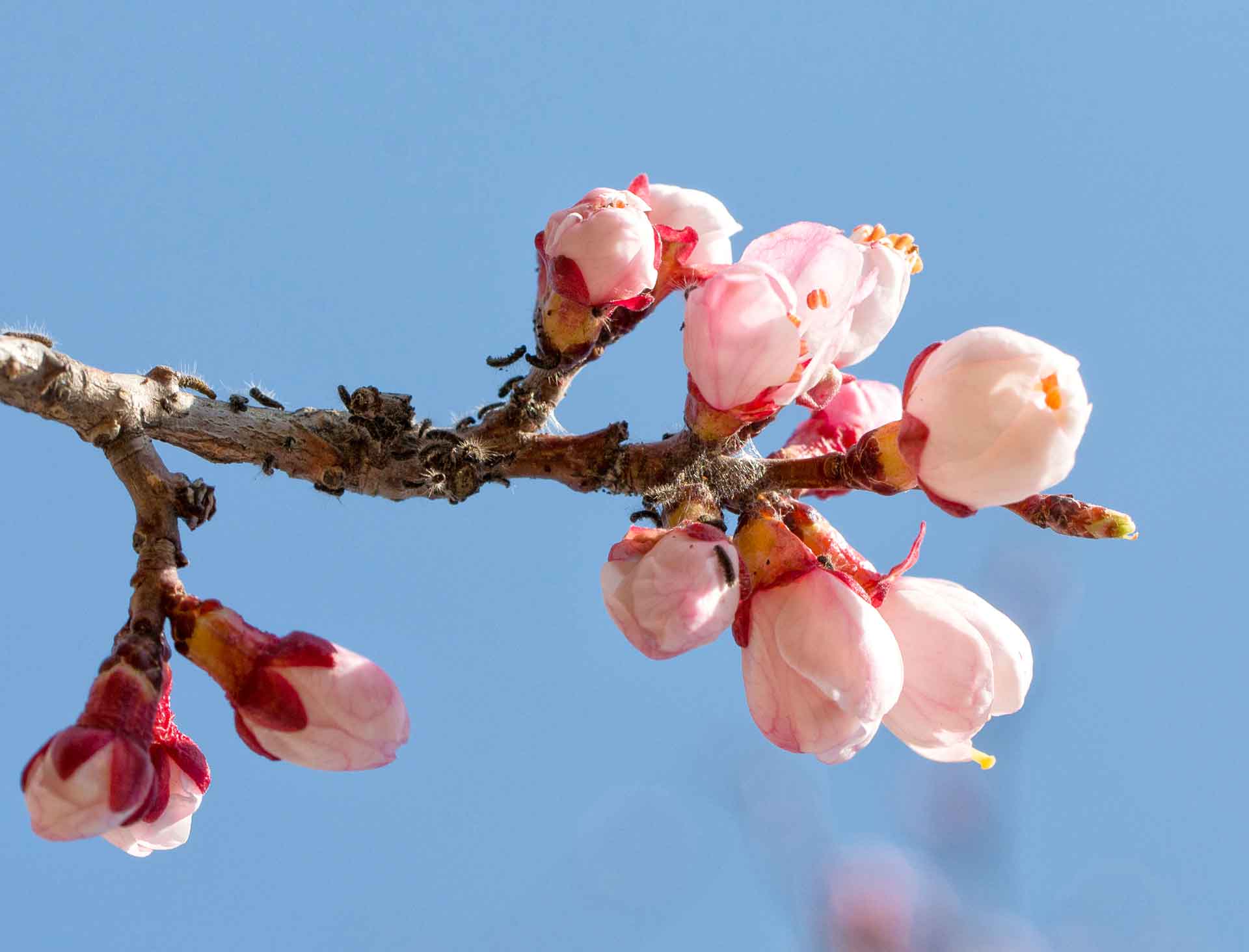From hull split through September, almond trees are undergoing flower-bud differentiation for next year’s bloom. Prolonged water stress during this period reduces the bloom density and fruit set the following year, significantly reducing yields. Thus, the post-harvest period is a critical time for almond irrigation.
Overview of Almond Flower Bud Differentiation
Flower bud differentiation is the process by which the apical meristem in the bud changes its anatomy to form flower buds instead of vegetative buds. The exact timing of differentiation depends on the variety and environmental factors, such as temperature. Additionally, not all buds on the tree begin to differentiate at the same time or same rate. Thus, at any given point during the process, a tree will have buds in many stages of flower bud development. The process occurs in several stages:
1. Initiation. The internal physiology of the growing point changes in response to plant hormones. This occurs prior to, or during, hull split, depending on temperatures and variety.
2. Stamen development. The internal structure changes and the stamen (pollen producing part of the flower) begins to develop. This stage typically occurs beginning in mid-August.
3. Carpel development. The components of the flower bud continue to develop and begin to form the carpels (structure comprised of the stigma and ovary). This stage occurs in late August through September, and the flowers will continue to develop over the autumn and winter.
Effects of Water Stress During Flower Bud Differentiation
Water stress results in reduced carbohydrate development. With less sugars available to the tree, there is less energy to devote to flower formation. Consequently, return bloom the following year will be lower in quantity (fewer flowers) and possibly quality. Water stress also affects the tree beyond flower formation. Premature leaf drop will prevent movement of macronutrients (nitrogen, potassium, phosphorous) from the leaves to the spurs for use next growing season.
Unfortunately, management practices that may best support flower development for next season may conflict with management practices required to get this year’s crop off the tree and delivered to the processor. For example, matching tree evapotranspiration (ET) water requirements during hull split may contribute to high levels of hull rot, or you may not be able to irrigate while nuts are drying on the orchard floor.
In 2000, David Goldhamer and Mark Viveros published an informative research study on understanding how water deficits during pre- and post-harvest affect return bloom. In this trial, trees were cut off from water at various times before harvest (ranging from 8 days to 57 days before shaking). Additionally, some trees received post-harvest irrigations, while other trees did not.
In this study, the irrigations with the most impact on return bloom were post-harvest irrigation events. The worst combination for return bloom was pre-harvest cutoff dates of more than 43 days with no post-harvest irrigation. This treatment reduced bloom density by 52 percent and kernel yield was off by 73 percent. However, even in trees with a short pre-harvest irrigation cutoff of only 8 days saw a 41 percent reduction in nuts per tree the following year if they did not receive a post-harvest irrigation. Among trees that received the post-harvest irrigations, pre-harvest cutoff timing did not influence the following year’s yield. Thus, post-harvest irrigations appear to be the most important in determining what the return bloom potential is for the following spring.
Managing for Next Year’s Bloom
As shown by Goldhamer’s research, irrigation strategies this season will impact your crop potential for next year. All managers should plan on meeting the tree water demands through at least the end of September. Be cognizant of the fact that micro-irrigation systems don’t recover soil moisture levels quickly following a long dry-down period. Utilize tools such as the pressure chamber to monitor the stress levels of your trees, as well as whether they have fully recovered following the harvest season.
Here are a few situations that you may face and some strategies for handling them:
1. Limited water availability
If you have limited water available, it is vitally important to apply the water when it is most critical to the tree development. Since the post-harvest irrigation timing is more critical to return bloom next year, it is better to have a longer irrigation cutoff period before harvest, then to irrigate right up until harvest and skip the post-harvest irrigations. A more in-depth discussion on deficit irrigation strategies during water shortages can be read in the publication “Drought Management For California Almonds”, available for free at: anrcatalog.ucanr.edu/pdf/8515.pdf.
2. Early defoliation (from water stress, mites, etc.)
Should your trees unexpectedly defoliate early due to stressors such as mites, return bloom will be improved by irrigating trees to induce re-leafing. Re-leafed trees will not produce as many flowers as a comparable tree that has not defoliated, but will have a heavier bloom than trees that did not re-leaf through the remainder of the growing season.
3. Varieties with a wide spread in harvest timings
Aim to reduce tree stress as much as possible throughout the harvest period. Ensure that shaking and pickup are done in a timely fashion to minimize the time the trees are not irrigated. Apply water as soon as possible after harvest. Consider installing a separate dripline for each variety so that irrigation can be maintained to the trees without compromising drying the nuts on the orchard floor.
References & resources
Doll, D., and Shackel, K. 2015 “Drought Management For California Almonds”, UC ANR Publication 8515. Available online at: anrcatalog.ucanr.edu/pdf/8515.pdf.
Goldhamer, D.A., Viveros, M. 2000. “Effects of preharvest irrigation cutoff durations and postharvest water deprivation on almond tree performance.” Irrigation Science. Vol 19: 125-131. Lamp, B.M., Connell, J.H., Duncan, R.A., Viveros, M., and Polito, V.S. “Almond Flower Development: Floral Initiation and Organogenesis.” Journal of the American Society for Horticultural Science. Vol 126(6): 689-696.
















